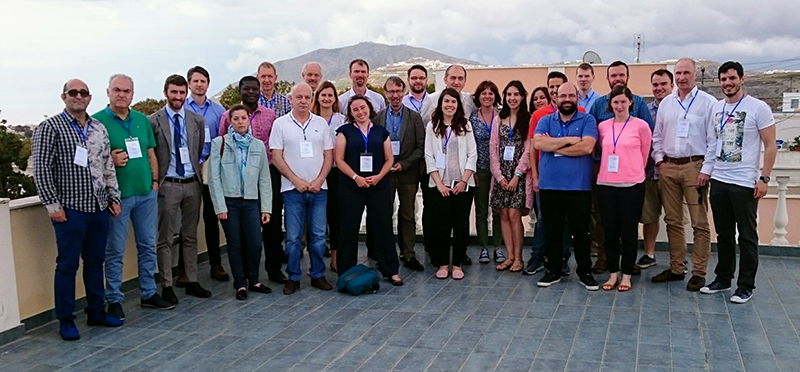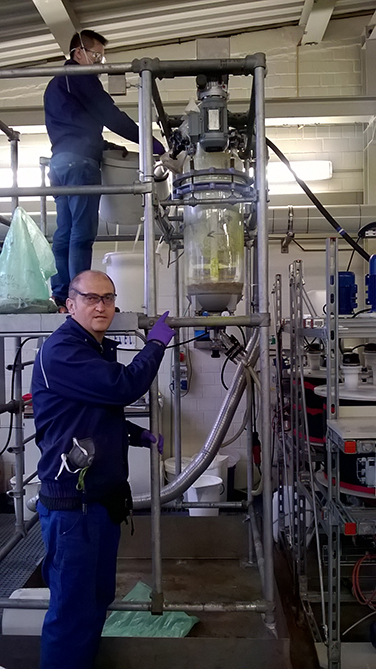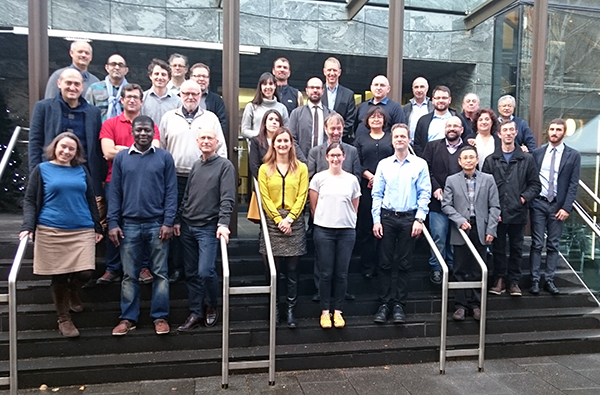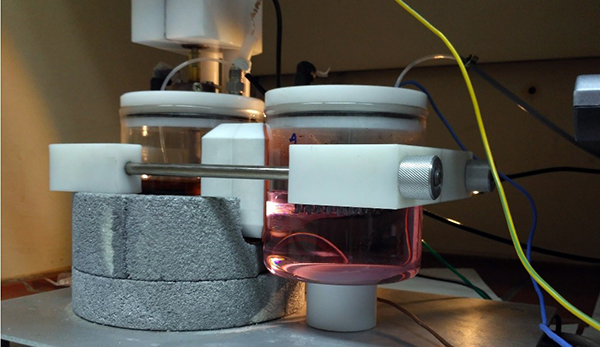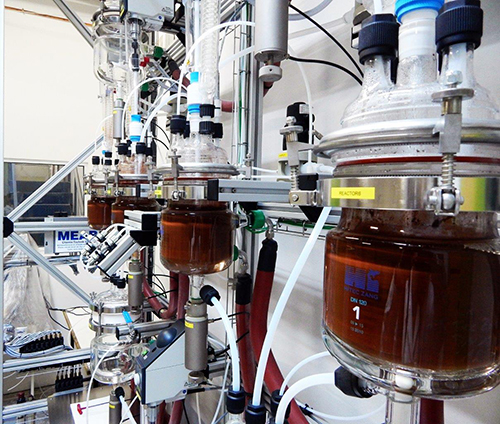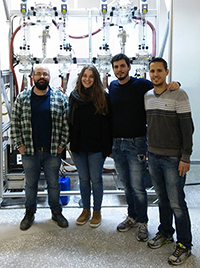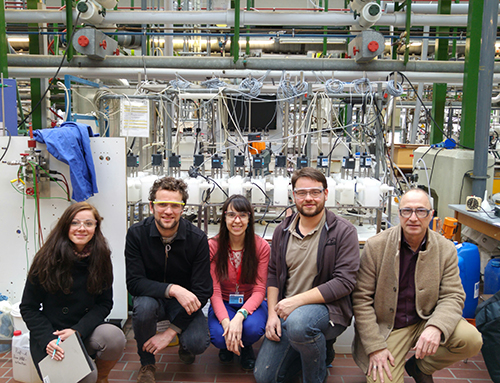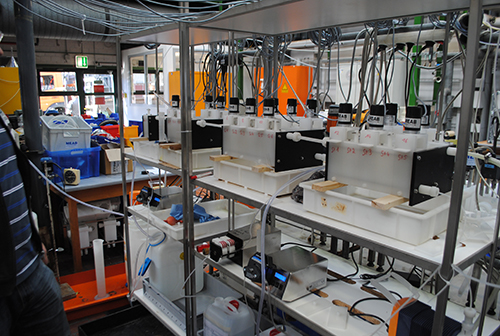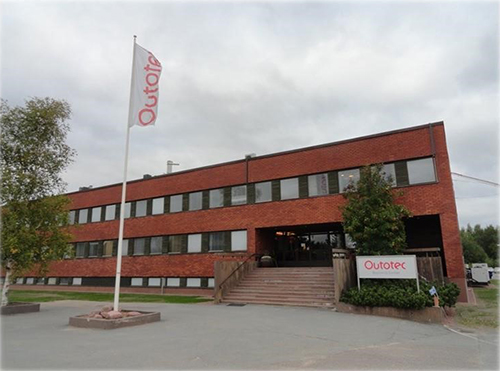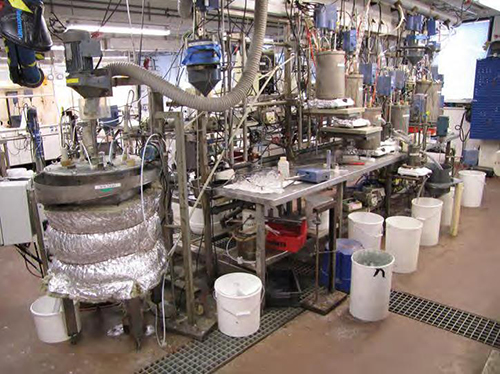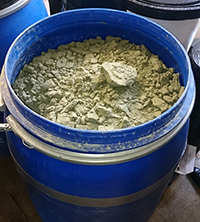News
Drilling in the Fen Carbonatite, November 2017
On November 15th, 2017, the Geological Survey of Norway, in cooperation with the geological advisor to the Buskerud, Telemark and Vestfold Counties, initiated drilling of the first of two 1000 m drill holes into the Fen Carbonatite Complex. This research drilling builds upon research carried out in the EURARE project. The drilling project is funded by the Norwegian government and is aimed to generate important material and data to further exploration and the understanding of carbonatite geology. Both drilling locations consist of REE-mineralized rauhaugite and have been selected to further clarify the potential for extractable REE minerals and the possibility for future mining. The 2000 m cores will be logged, scanned and analyzed, and all data released to the public.
ERES2017 and EURARE progress meeting, Santorini, May 2017
An EURARE progress meeting was held in Santorini in May, and was followed by the very successful Second European Rare Earth Resources conference (ERES2017). This meeting, at the Petros M Nomikos conference centre in Thira, was extremely successful, with over 100 presentations on all aspects of the rare earths supply chain and more than 200 attendees. The full programme for the conference can be found here
EURARE in the news, April 2017
EURARE project work to extract rare earth elements from bauxite residue has been showcased in the media by Euronews. Project coordinator Dr Thymis Balomenos appears in the short film made by Euronews.
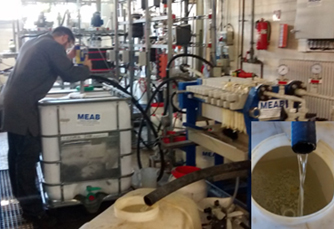
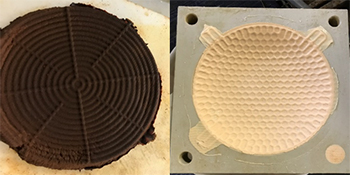
Hydrometallurgical processing of eudialyte concentrate, April 2017
EURARE researchers at the RWTH Aachen University, Germany, have processed 500 kg of eudialyte concentrate, containing 1-2 % total rare earth elements, from two deposits, Norra Kärr, Sweden and Kringlerne, Greenland. The processing of these concentrates using hydrometallurgical processing steps was undertaken using MEAB's demonstration plant, located at the IME Process Metallurgy and Metal Recycling of the RWTH Aachen University.
The final product: 24 kg of high quality (45 % total rare earth oxide) rare earth carbonate following the final removal of iron by oxidation and selective ferric hydroxide precipitation. This method, developed by MEAB engineers, was performed over two weeks in collaboration with the IME team.
Release of the EURARE Roadmap for the REE material supply autonomy in Europe, April 2017
EURARE has just released its roadmap for REE material supply autonomy in Europe. This report was written by EURARE partners GEUS and D'Appolonia. This report maps and places into context European industrial activities that either produce or consume REE. It describes key issues around mining and processing of REE, and the intermediate REE-industrial sector. It gives a description of global and EU REE markets and provides forecasts for REE-demand in various industrial sectors with a view to EU2020 renewable energy targets up to 2025 and 2030.
Recovery of REE from eudialyte concentrate, January 2017
A treatment of eudialyte concentrate was performed with concentrated 30% hydrochloric acid in the demonstration plant at the IME Process Metallurgy and Metal Recycling lab of RWTH Aachen University. A fuming process represents the first operation of our hydrometallurgical strategy in order to transfer rare earth elements from concentrate into solution whilst avoiding silica gel formation. The details of this process have recently been published in Minerals Engineering.
EURARE project progress meeting in Edinburgh, UK, December 2016
A progress meeting for the EURARE project was held in Edinburgh, UK, on the 6th and 7th of December 2016, hosted by the British Geological Survey with a dinner sponsored by project partners Johnson Matthey. This meeting included final reports from several work packages that will finish at the end of 2016. The EURARE data portal (the IKMS) is now live with data on REE deposits and occurrences across Europe, and a report on the REE value chain in Europe is being finalised. Metallurgical work at lab scale has largely been completed and pilot tests are under way for a range of methodologies for REE extraction and separation. The next meeting will be held in Santorini immediately before the ERES2017 conference.
Pilot tests for REE metal production using ionic liquids, November 2016
The first pilot scale tests have begun in a prototype electrochemical reactor in NTUA. The method used in the laboratory of metallurgy at NTUA is based on the electrolytic reduction of rare earth cations, with the final aim being production of metallic rare earths. The system used is a novel electrolytic system based on hydrophobic ionic liquids, containing rare earth cations. The ionic liquids are 'green' electrolytes, with low vapour pressure and without the emission of fluoride or chloride compounds present in molten salts. The molten salts currently used for REE extraction require high operating temperatures (in some cases > 1000°C), while the technology in this pilot study has the advantage that is performed at ambient conditions, and is thus attractive in terms of energy consumption.
The Ionic Liquid (IL) pilot plant at the National Technical University of Athens (NTUA) has begun operating, October 2016
The plant is selectively extracting rare earth elements (REE) from bauxite residue (red mud), the waste product of alumina production from bauxite, using functionalized Ionic Liquids. The residue has been provided by Aluminium of Greece. The IL can be regenerated and reused after each leaching cycle.
The REE content in the hosting aqueous solution is enriched by a factor of between 3 and 16 depending on the REE.
Upon completion of the Bauxite Residue (red mud) pilot scheme, the same technology will be used to recover REE from the Rodberg ore from Norway (Fen Minerals).
Project Progress Meeting in Uppsala, June 2016
The EURARE consortium had its 6th progress meeting in Uppsala, Sweden between 6th and 8th of June 2016, hosted by partners SLU and SGU. The project has progressed across all work packages as it is entering its final 18 month period. R&D packages are concluding their activities while pilot plant demonstration continues with leaching and separation work in Aachen and Athens. After the meeting the team visited the historical Ytterby and Bastnäs mines, where many of the rare earth elements were first discovered.
ERES2017 - 2nd Conference on European Rare Earth Resources
28-31 May 2017 – PETROS M. NOMIKOS CONFERENCE CENTRE – Santorini, Greece
Following the success of the 1st ERES conference in 2014 and under the framework of the EURARE: Development of a sustainable exploitation scheme for Europe's rare earth ore deposits FP7 research project and the EREAN: European Rare Earth (Magnet) Recycling Network Marie-Curie Initial Training Network, the 2nd European Rare Earth Resources conference will be held in 2017 in Santorini, Greece.
The Conference will include both geological and metallurgical topics for production of REE from primary and secondary REE resources. The conference will include both oral presentations and intensified poster presentations (3 min presentations in an auditorium). The official language of the conference is English.
Call for abstracts
Deadline for Abstract Submission 30/11/2016.
Registration
The online registration is now open
More information
Ionic Liquid pilot plant in Athens commissioned, March 2016
The Ionic Liquid pilot plant at NTUA in Athens is now being commissioned. The plant will be used to selectively leach REE from the bauxite residue of the alumina industry. The annual bauxite residue production from aluminium of Greece potentially contains approximately 10% of European REE raw material demand.
A new EU-funded project, HiTech AlkCarb, has started in February 2016
The project aims to develop geomodels for REE and other critical metals in alkaline rocks and carbonatites.
KU Leuven team visits Aachen, February 2016
In February 2016 the EURARE team from KU Leuven visited Aachen to see progress on the separation and purification demonstration plant at MEAB. Dr Stopic from IME, RWTH Aachen, also invited the group for lunch and presented ongoing separation activities at IME.
MEAB solvent extraction demonstration under way, January 2016
MEAB have successfully started their solvent extraction demonstration plant in Aachen. Working with rare earth carbonate produced from Kvanefjeld ore, they will conduct three separation steps: 1) Separation of HREE fraction from mixed MREE and LREE fraction; 2) Separation of the MREE and LREE fractions; and 3) separation of Pr and Nd as individual elements.
Article in 'Chemical Engineering', January 2016
A news article on the Kvanefjeld refinery pilot test, part of the EURARE project, has been published in 'Chemical Engineering'. Read the full article here: http://www.chemengonline.com/progress-e-u-project-produce-rare-earth-elements-greenland/?printmode=1
Project progress meeting in Aachen 2015
The EURARE project partners met for a progress meeting in Aachen in December 2015. Progress is good across all work packages. Work Package 2 on beneficiation is coming to an end, and a full summary of their work on beneficiation was presented. The project team visited the laboratories in RWTH and MEAB where extraction and separation testing will be carried out.
Successful production of mixed rare earth carbonate from Kvanefjeld ore at Outotec, Finland, October 2015
The Kvanefjeld Refinery Demo commenced on the 31st of October and was completed on the 5th of October at Pori Research Laboratories in Finland. EURARE partners Outotec and Greenland Minerals and Energy co-operated closely for this work. Approximately 25 kg of rare earth carbonate was produced from Kvanefjeld ore. The next stage involves sending the rare earth carbonates to MEAB, Aachen, Germany for separation into individual oxides.
Successful beneficiation of Norra Kärr ore, September 2015
A successful run of the beneficiation pilot plant at GTK was carried out in September 2015, using Norra Kärr ore. Mineral concentrate produced in this test is now with RWTH Aachen for leaching.
Europe's REE resources reviewed, September 2015
The EURARE project has published a review of Europe’s rare earth element resource potential in Ore Geology Reviews: the paper is Open Access and available at http://dx.doi.org/10.1016/j.oregeorev.2015.09.019
ERECON final report, June 2015
The final report of the European Rare Earths Competency Network (ERECON) was released in June 2015: http://ec.europa.eu/growth/sectors/raw-materials/specific-interest/erecon/index_en.htm
SoS RARE project

The SoS RARE project aims to understand the mobility of REE in natural systems and apply this to mineral processing, and will work in partnership with EURARE. For more information, visit www.sosrare.org
Successful beneficiation of Kvanefjeld ore, April 2015
Successful run of beneficiation pilot plant at GTK, using Kvanefjeld ore.
Horizon magazine article, March 2015
EURARE project discussed in Horizon magazine article
Red Mud project
The Red Mud project is working on processing of bauxite and red mud, including research on recovery of REE that directly relates to the work of EURARE. For more information, visit http://redmud.org/


